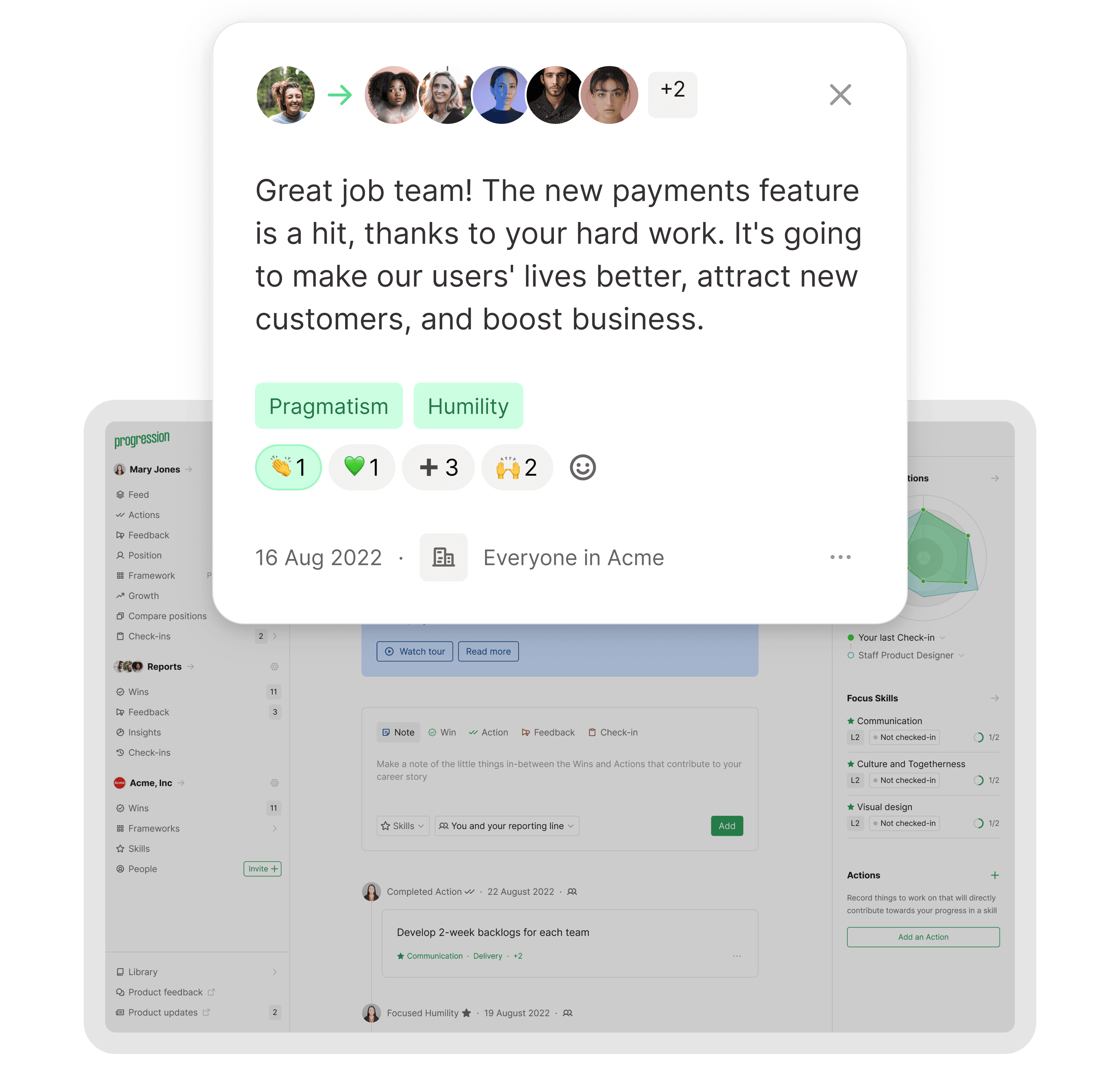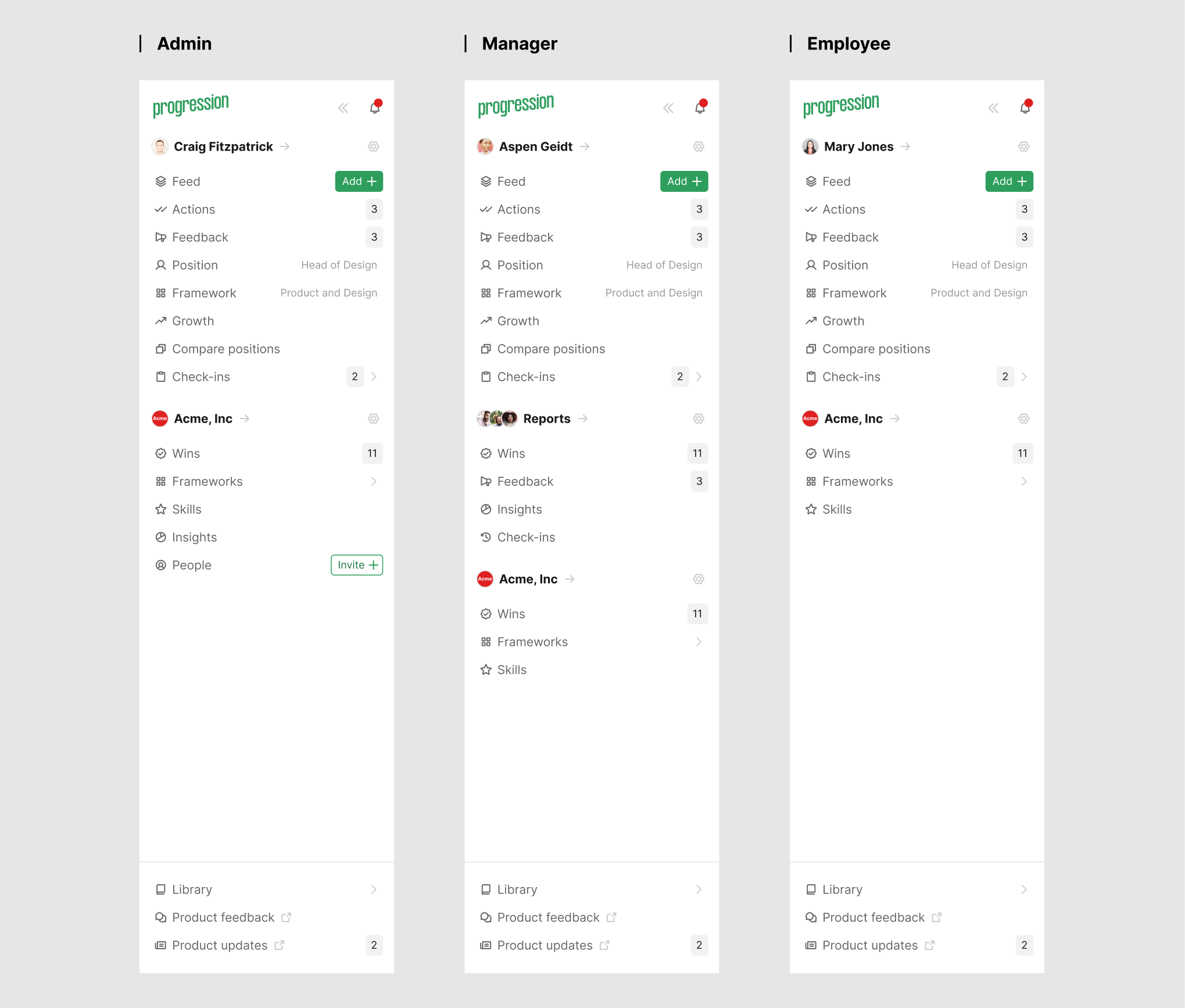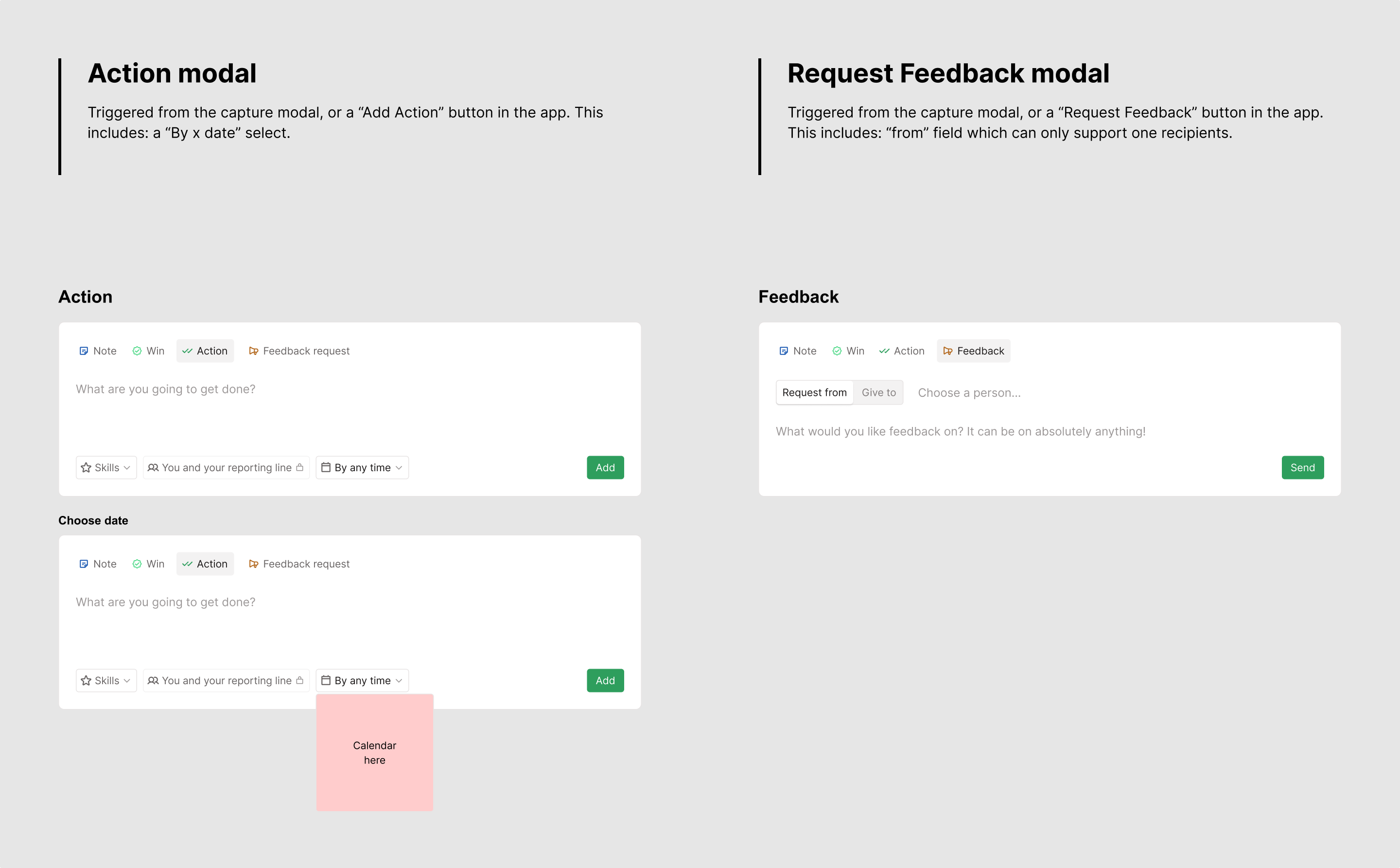Boosting retention and WAUs with Wins

Industry
HR & Career techYear
2022My involvement
At Progression, we built a career development platform with the aim of enabling everyone to have a career that they love. During Q3 and Q4 2022, I worked on refining and improving the recognition feature, called “Wins”.
The challenge
In the Progression app, one of our key user groups consisted of Individual Contributors (ICs), non-management employees. However, these ICs were primarily engaging with Progression infrequently to do Check-ins, which occurred only every 3-6 months.
This limited interaction meant that the platform was underutilised, and failed to empower employees effectively. Therefore, ICs were not regularly using the app, posing a heightened risk of churn, diminished value, and decreased engagement among our other critical user groups: HR teams and managers. Recognising this opportunity, my team and I embarked on a mission to rejuvenate the app's core experience, starting with Wins, but ultimately aiming to craft an experience that would be valued and loved by ICs and managers alike.
The team
Product Designer (me), Product Manager, 2 × Engineers
Objectives
- Increase regular core feature usage and PMF score
- A set of directional features to communicate publicly
- Increase WAUs and MAUs by engaging users — both existing and new
Discovery
Research
To kickstart our project, our team engaged in extensive conversations with over 20 managers and employees. Through these discussions, a distinct pattern emerged among high-performing employees who consistently advanced in their careers. They shared a common practice: diligently collecting, curating, and showcasing their achievements to their managers during performance reviews. Managers echoed this sentiment, emphasising that well-prepared performance reviews were far more effective for aligning expectations and assessing employee competence.
One employee from a 200+ person tech company succinctly stated their approach:
“I've always found it really easy to get promoted, I usually get a promotion every 6-12 months. I take my doc into reviews with me. It's a collection of my achievements, impacts, and commendations, written by people my boss respects.”
On the flip side, another group expressed frustration with their lack of career progression. They cited a significant barrier to this as their inability to consistently document their achievements, often due to time constraints or forgetfulness. Some employees believed they possessed specific skills but struggled to convey their proficiency effectively. Managers indicated a need for tangible evidence to substantiate these claims within the company's context.
“I know I should be keeping a log of my achievements and project results, but I just get caught up in my day-to-day work”
— confessed a designer at a 5,000+ employee publishing company.
Driven by the goal of democratising this process, my mission became more focused on cultivating a habit of data collection for all employees. Additionally, I sought innovative ways to harness the social dynamics of the workplace, allowing employees to collaboratively generate valuable data for each other. I also believed there was an opportunity to create a network effect that could enhance engagement with Progression across the entire organisation.
Exploration
As a team, we got together and did an Opportunity Solution Tree (pioneered by Teresa Torres in Continuous Discovery Habits) workshop, to draw out all of the ideas we have in this space.

We focused on “Building habit, stickiness and a sense of belonging” branch of the Opportunity Tree. Within that branch there were three high-level opportunities we identified:
- Build habit by nudging people to engage, inside and outside of the product
- Exploit the power of peers and community to help me progress
- Make people love our brand and feel part of the ‘Progression movement’
I dove deeper into the opportunity of nudging people to engage, and used the Hooked Model (as pioneered by Nir Eyal in Hooked) to explore ways we could draw people back into the app, and create a stickier experience.

Both of these exercises gave us a array of opportunities to pursue. Given the relatively small amount of daily and weekly active users. We decided the best course of action was to focus on speed of learning, by building and validating our ideas as quickly as possible.
The engineers and I sketched out a basic flow for how an improved Slack integration feature would work. As well as discussing how this experience could be built iteratively.

Final designs
We began by launching a number of small but high impact experiments. All of which were positively received and led to increases in engagement.
Win visibility
Initially, wins were only visible to the person that created them, the receiver, and the receivers management line. We heard many customers say they’d really like to have the option of sharing wins with their whole company too. In enabling this, we hoped that seeing wins for others may spark people to share wins of their own.


Win reactions
Acknowledging receiving a win was something that people didn’t always remember to do, and was done either by email or Slack. So we added an option to add a quick reaction to a win too. Which also enabled people to “pile on” to wins given to others and add a ➕ or 👏 to boost a win given by someone else.

One-to-many Wins
Another barrier to win giving we were told about, was that sometimes an achievement is shared. Multiple people were responsible for an achievement. So we added the ability to give a win more than one person.


Win Slack integration and notifications
Adding all this extra functionality was applauded and used regularly by our users that were already logging in regularly. However, to reach a wider audience — as explored in my Hook Model canvas — we needed to draw people back to the app.
We did this by improving the Slack integration, so it would notify people about: wins received, win reactions and reactions to wins they’d given. We also removed the requirement to tag a Win with a skill.
Lastly, we launched a weekly win notification that would pop up in the channel of the customers’ choosing on Friday’s at 3pm.
View Integration page on Slack App Directory

Alongside this project, I worked on refining the holistic experience in the app by:
- Redesigning the navigation
- Adding a feedback feature, which was frequently requested
Whilst another team also:
- Added the ability to create actions
- Added the ability to focus on up to 3 skills
- Refined the check-in experience
Which meant the app had increased in complexity. So my team and I were challenged with refining the IA and overall app experience. We did this by releasing the following, three major new features.
New navigation
The first major overhaul of the navigation since the app was launched. I spent time thoroughly exploring many different options, and tested these with customers. After several rounds of testing and feedback, we launched this new side navigation.

Work feed
The new default home page for all users of the app. Where they can see a timeline of everything that’s contributed to their career development in the app. Including: wins received, actions created and completed, feedback received, and lastly, check-ins started and completed.



Create box
Where people could quickly “create” any type of content they needed to. Whether it was a win, action, feedback, or start a check-in.
The new modal I designed, was designed to look and feel more modern. As well as being accessible from anywhere in the app via a shortcut in the navigation.



Outcomes
Results
All from H2 (July—December) 2022
Slack enabled
22 → 61
Grew the total number of orgs with Slack enabled from 22 to 61, a 177% increase.
With the total growing to 105 by end of H2 2023, which was a 477% increase from before the project started.
Wins
5,638 Wins Created
Up by 41% in Q3 and another 10% in Q4, compared to previous quarters.
Win notifications
8.23% led to a Win created by the receiver
With 26.25% leading to a reaction being added to a win by the receiver
Win reactions
2,505 Win Reactions created
With 60% being done in-app, and the rest being done by slack, and then email.
61% of Win reactions were created in-app, with 23% coming from Slack, and 14% from email.
Win reaction notifications
14.67% led to a Win being created by the receiver
With 18.25% led to another reaction being added
Win visibility
2,027 Wins were org visible
Making 35% of all wins visible to everyone in the org, and also being posted to Slack.
One-to-many wins
16.82% of Wins had multiple winners
What next
The new functionality was warmly received by our customers, and led to:
- A 35% increase in weekly active users
- An increase in actions per active user in each session
- An increase percentage of users active per org
Wins are now empowering even more employees and managers to have better career conversations because of Progression.